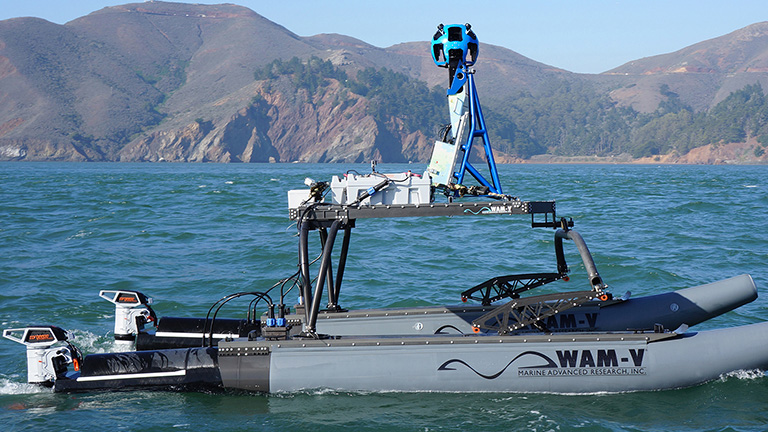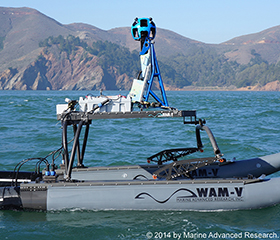A new unmanned vessel, launched with the help of Google, will map shorelines and raise awareness of the impacts of global sea level rise. The high-tech boat boasts innovative technologies from the boatbuilding, propulsion and mapping fields.
“It’s a Google Boat,” says staff scientist for the San Francisco Baykeeper organization, Ian Wren.
The small, remote-controlled catamaran, a Wave Adapted Modular Vehicle (WAM-V) designed by Marine Advanced Research, features an adaptive hull design that flexes to adapt to the water’s surface and provides ultimate stability. Originally designed to be worn by backpackers, Google’s proprietary Street View Trekker camera system was provided on loan to the Baykeeper organization, allowing them to create stunning, bay-level maps. Clean, powerful and efficient propulsion was a high priority. The group turned to electric propulsion innovator Torqeedo for that task.
The Baykeeper organization plans on using the imagery collected — nearly 500 miles of coastline ranging from San Jose to Antioch, California — on its website and for educational purposes, helping illustrate the threats posed by global sea level change to critical wetlands.
“A lot of people know about sea level rise,” says Sejal Choksi, an environmental lawyer and Baykeeper’s interim director. “We are hoping these images will really bring the reality home to the public, that they will look at pictures of places they know and say, 'Oh my gosh, this is going to be underwater.’”
Baykeeper’s WAM-V sports twin Cruise 4kW electric outboard motors rigged with Power 24-3500 lithium batteries. The WAM-V is able to run for hours with nearly zero environmental footprint, thanks to onboard traditional and solar charging capabilities.
The Google Trekker, WAM-V and Torqeedo technology has also recently completed a mapping project of American Samoa that can be seen here.
For more information on the San Francisco Baykeeper’s Google Boat project, visit the organization at www.baykeeper.org.

